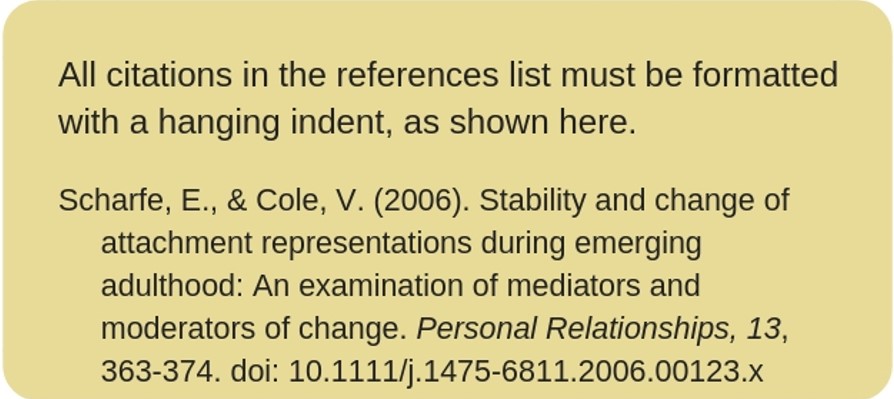Citing Reports, Personal Communications, and Media
Notice: This guide provides information about APA 6th edition (2010) citation and referencing requirements. For information on citing and referencing in APA 7th edition (2020), please see our updated APA 7 guide.
- Personal Communication (Including Lectures)
- Entry in a Reference Book (Dictionary or Encyclopedia)
- Published Doctoral Dissertation or Master’s Thesis
- Government Documents/Reports
- Report from Nongovernmental Organization
- Film
- Television Program (Single Episode from a Series)
- Sound Recording

Personal Communication (Including Lectures)
In-Text Citation
Example:
References
Entry in a Reference Book (Dictionary/Encyclopedia)
Entry in Online Reference Work
In-Text Citation
("Cognitive Dissonance," 1999)
References
Article Title. (Year of Publication). In Title of Online Book. Retrieved from web address.
Example
Cognitive dissonance. (1999). In The Cambridge dictionary of philosophy. Retrieved from http://www.credoreference.co/entry/cupdphil/antecedent
Article/Entry in a Print Reference Book
In-Text Citation
("Cognitive Dissonance," 1998)
References
Article Title. (Year of Publication). In Editor's First Initial and Last Name (Ed.), Title of Book (pp. #-#). City Where Published: Publisher.
Example
Cognitive dissonance. (1998). In D. A. Statt (Ed.), The concise dictionary of psychology (p.26). New York: Routledge.
Published Doctoral Dissertation or Master's Thesis
In-Text Citation
References
Example:
Notice:
Government Report
In-Text Citation
References
Example:
Environment Canada. Canadian Wildlife Service. (2004). The 1995 peregrine falcon survey in Canada. U. Banasch & G. Holroyd (Eds). (Occasional Paper no. 110). Retrieved from http://www.cws-scf.ec.gc.ca/publications/AbstractTemplate.cfm?lang=e&id=...
Notice:
- When a URL is too long to fit on one line, create a break where there is punctuation (period, slash, dash). As you can see in the example, the punctuation starts the next line. Do not end the URL with a period if it is not in the original.
Report from Nongovernmental Organization
In-Text Citation
(Kenney, Cook, & Pelletier, 2009)
References
Example:
Kenney, G. M., Cook, A., & Pelletier, J. (2009). Prospects for reducing uninsured rates among children: How much can premium assistance programs help? Retrieved from Urban Institute website: http://www.urban.org/url.cfm?ID=411823
Notice:
- If a document from an NGO has no author, follow the rules for a corporate author.
- If the document is in print, follow the rules for print publications, including the publishing information (city and publisher).
- When a URL is too long to fit on one line, create a break where there is punctuation (period, slash, dash); the punctuation starts the next line. Do not end the URL with a period if it is not in the original.
Film
In-Text Citation
(Diamant, Rodgers, & Hark, 1997)
References
Example:
Television Program (Single Episode from a Series)
In-Text Citation
References
Example:
Sound Recording
In-Text Citation
(Artist's last name, year of publication, side or track numbers)
Example:
(Lennon & McCartney, 1968, track 3)
References
Examples:
Cohen, L. (1984). Hallelujah [Recorded by J. Buckley]. On Grace [CD]. New York: Columbia. (1994).

